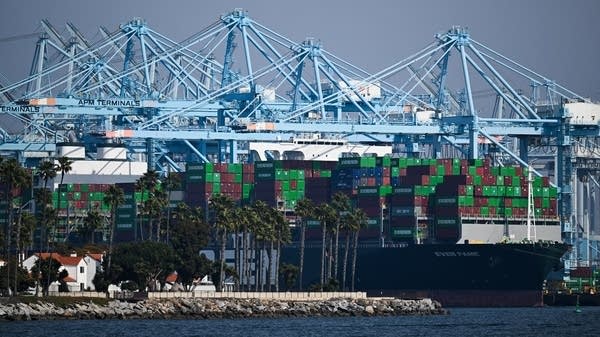Where is our tariff revenue going?
The U.S. collects billions in tariff revenue each year and it all ends up with the U.S. Treasury.

This is just one of the stories from our “I’ve Always Wondered” series, where we tackle all of your questions about the world of business, no matter how big or small. Ever wondered if recycling is worth it? Or how store brands stack up against name brands? Check out more from the series here.
Listener Camille Nelson from Houston asks:
How do tariffs wind up in the U.S. Treasury? Can we follow the money from assessment to collection to deposition to allocation to expenditure to see whether they're substantively different from other taxes?
You can think of tariffs as taxes imposed on U.S. companies. They have to pay the U.S. government duties on goods that they import. And just like your taxes, they end up with the U.S. Treasury.
President Donald Trump has imposed tariffs on countries around the world during his second term, including a 10% baseline tariff on most imports and a 30% tariff on most Chinese imports.
To make up for tariffs, companies can eat the costs and/or pass them along to consumers in the form of higher prices. Some businesses have already raised prices or plan to, like Walmart, Costco and Mattel.
Tariffs are generally considered regressive taxes because lower-income households are the ones who are least able to afford the goods we’re importing, said Jack Zhang, an assistant professor of political science at the University of Kansas.
Companies have their own version of the U.S. tax code called the Harmonized Tariff Schedule, which tells them what the tariff rate is for specific goods from specific countries, said Timothy Meyer, a professor at Duke University School of Law.
The business that’s importing a good is called the “importer of record,” and they have to make a declaration about the origin of the product and what the product actually is. U.S. Customs Border and Protection will then determine what the tariff rate is, Meyer explained.
“In order to keep things moving, the importer pays the duty immediately, based on what is essentially a preliminary assessment by CBP,” Meyer said.
The process is designed to ensure that these imported goods aren’t just sitting at the port, unable to be resold or offered on the market while the final tariff rate is determined, Meyer said.
As for how companies pay these duties? “You wouldn't be using a credit card or PayPal or something like that. It would be in the form of a bank transfer,” Meyer said.
Companies can challenge or “protest” the duty if they think the agency has misclassified the product or incorrectly identified its country of origin, he said.
The CBP will conduct an internal review process, which could take months. If a company still isn’t satisfied with the agency’s ultimate determination, they can file a lawsuit at the Court of International Trade, which is a federal court that has jurisdiction over tariff-related matters, he explained.
But if everything goes smoothly, the CBP sends tariff revenue to the U.S. Treasury’s general fund, which is where our federal income taxes also go.
The president, the Treasury Secretary and the CBP do not have the discretion to spend that money.
“President Trump, will sort of talk as if he's got this money that can be spent. It cannot be spent unless Congress authorizes and appropriates it to be spent for a particular purpose,” Meyer said. “It's just a tax in the same way the president cannot just turn around and spend the income tax dollars that the IRS collects and remits into the general revenue of the Treasury.”
The tariff revenue that the U.S. Treasury collects isn’t earmarked for a specific goal.
“Tariff revenue is very fungible, so once it gets moved to the general account, it can really be spent on anything,” Zhang said.
Congress uses money from the general fund to help finance programs like Medicare and the military.
The U.S. has already brought in nearly $73 billion in revenue from tariffs so far this year, compared to $77 billion in tariff revenue for the entirety of 2024.
But during the trade war under the first Trump administration, farmers not only had to pay more for equipment thanks to tariffs on U.S. imports, but the countries they exported to placed retaliatory tariffs on their goods. The Trump administration ended up paying farmers $23 billion to offset their economic losses.
Economists consider tariffs a “deadweight loss” because of trade-offs like these, Zhang said.
Even if the Trump administration didn’t provide those subsidies, tariff revenue is still just a drop in the bucket. That $77 billion the U.S. raked in last year accounted for just 1.57% of total federal revenue.
And remember: U.S. shoppers are likely paying for a good chunk of tariff revenue since companies tend to pass down the costs of tariffs to consumers.













